 Web Front-end
Web Front-end JS Tutorial
JS Tutorial In-depth understanding of JavaScript series (16) Closures_javascript skills
In-depth understanding of JavaScript series (16) Closures_javascript skillsIntroduction
In this chapter we will introduce a topic that is often discussed in JavaScript - closure. In fact, everyone has already talked about closures. Nonetheless, here we will try to discuss closures from a theoretical perspective and see how closures in ECMAScript actually work internally.
As mentioned in the previous article, these articles are a series of articles and are related to each other. Therefore, in order to better understand the content to be introduced in this article, it is recommended to read Chapter 14 Scope Chain and Chapter 12 Variable Objects first.
English original text: http://dmitrysoshnikov.com/ecmascript/chapter-6-closures/
Introduction
Before discussing ECMAScript closures directly, it is still necessary to take a look at functional programming Some basic definitions.
As we all know, in functional languages (ECMAScript also supports this style), functions are data. For example, functions can be assigned to variables, passed as parameters to other functions, returned from functions, etc. Such functions have special names and structures.
Definition
A functional argument (“Funarg”) — is an argument which value is a function.
A functional argument (“Funarg”) — is an argument whose value is a function.
Example:
function exampleFunc(funArg) {
funArg();
}
exampleFunc(function () {
alert('funArg');
});
In the above example The actual parameter of funarg is actually the anonymous function passed to exampleFunc.
Conversely, a function that accepts functional parameters is called a high-order function (HOF for short). It can also be called: functional function or partial mathematical theory or operator. In the above example, exampleFunc is such a function.
As mentioned before, functions can not only be used as parameters, but also as return values. Such functions that return a function are called functions with functional value or function valued functions.
(function functionValued() {
return function ( ) {
alert('returned function is called');
};
})()();
A function that can exist in the form of normal data (for example : When parameters are passed, accept functional parameters or return function values), they are called first-class functions (generally speaking, first-class objects). In ECMAScript, all functions are first-class objects.
Functions that can exist as normal data (for example, when parameters are passed, accept functional parameters or return function values) are called first-class functions (generally speaking, first-class objects).
In ECMAScript, all functions are first-class objects.
A function that accepts itself as a parameter is called an auto-applicative function or self-applicative function:
(function selfApplicative(funArg) {
if (funArg && funArg === selfApplicative) {
alert('self- applicative');
return;
}
selfApplicative(selfApplicative);
})();
with self as the return value The function is called an auto-replicative function or self-replicative function. Usually, the term "self-replicating" is used in literature:
(function selfReplicative() {
return selfReplicative;
})();
One of the more interesting patterns for self-replicating functions is to accept only one item of a collection as Parameters are accepted instead of accepting the collection itself.
// Function that accepts a collection
function registerModes( modes) {
modes.forEach(registerMode, modes);
}
// Usage
registerModes(['roster', 'accounts', 'groups']);
//Declaration of self-copying function
function modes(mode) {
registerMode(mode); // Register a mode
return modes; // Return the function itself
}
// Usage, modes chain call
modes('roster')('accounts')('groups')
//Somewhat similar: jQueryObject.addClass("a") .toggle().removClass("b")
But passing the collection directly is relatively effective and intuitive.
Variables defined in functional parameters can be accessed when "funarg" is activated (because the variable object storing context data is created each time the context is entered):
function testFn(funArg) {
//When funarg is activated, local The variable localVar can be accessed
funArg(10); // 20
funArg(20); // 30
}
testFn(function (arg) {
var localVar = 10;
alert(arg localVar);
});
However, we know from Chapter 14 that in ECMAScript, functions can be encapsulated in parent functions , and can use variables from the parent function context. This feature can cause funarg problems.
Funarg problem
In a stack-oriented programming language, the local variables of a function are stored on the stack. Whenever the function is activated, these variables and function parameters will be pushed onto the stack. .
When the function returns, these parameters will be removed from the stack. This model places significant restrictions on using functions as functional values (for example, as return values from parent functions). Most of the time, problems arise when functions have free variables.
Free variables refer to variables that are used in a function but are neither function parameters nor local variables of the function
Example:
function testFn() {
var localVar = 10;
function innerFn( innerParam) {
alert(innerParam localVar);
}
return innerFn;
}
var someFn = testFn();
someFn(20); // 30
In the above example, for the innerFn function, localVar is a free variable.
For systems that use a stack-oriented model to store local variables, this means that when the testFn function call ends, its local variables will be removed from the stack. In this way, when the function call to innerFn is made from the outside, an error will occur (because the localVar variable no longer exists).
Moreover, in the above example, in the stack-oriented implementation model, it is simply impossible to return innerFn as a return value. Because it is also a local variable of the testFn function, it will also be removed when testFn returns.
Another problem is when the system uses dynamic scope and functions are used as function parameters.
Look at the following example (pseudocode):
var z = 10;
function foo() {
alert(z);
}
foo(); // 10 – Using static and dynamic scopes When
(function () {
var z = 20;
foo(); // 10 – use static scope, 20 – use dynamic scope
})();
// It’s the same when foo is used as a parameter
(function (funArg) {
var z = 30;
funArg() ; // 10 – static scope, 30 – dynamic scope
})(foo);
We see that using dynamic scope, variables (identifiers) The system is managed through a dynamic stack of variables. Therefore, free variables are queried in the currently active dynamic chain, rather than in the static scope chain that was saved when the function was created.
This will cause conflict. For example, even if Z still exists (as opposed to the previous example of removing the variable from the stack), there is still a question: which value of Z takes on different function calls (from which context, which scope) query)?
The above describes two types of funarg problems - depending on whether the function is returned as a return value (the first type of problem) and whether the function is used as a function parameter (the second type of problem).
In order to solve the above problems, the concept of closure is introduced.
Closures
A closure is the combination of a block of code and the data in the context in which the block of code was created.
Let’s look at the following example (pseudocode):
var x = 20;
function foo() {
alert(x); // Free variable "x" == 20
}
// is foo closure
fooClosure = {
call: foo // Reference to function
lexicalEnvironment: {x: 20} // Search context's context
};
In the above example, the "fooClosure" part is pseudocode. Correspondingly, in ECMAScript, the "foo" function already has an internal property - the scope chain that creates the context of the function.
"lexical" is usually omitted. The above example is to emphasize that when the closure is created, the context data will be saved. The next time the function is called, the free variable can be found in the saved (closure) context, and as shown in the above code, the value of the variable "z" will always be 10.
We use the broader term "code block" in the definition, however, usually (in ECMAScript) we use functions that we often use. Of course, not all implementations of closures will tie closures and functions together. For example, in Ruby language, closures may be: a procedure object, a lambda expression or code block.
For the purpose of saving local variables after the context is destroyed, the stack-based implementation is obviously not applicable (because it conflicts with the stack-based structure). Therefore, in this case, the closure data of the upper scope is implemented by dynamically allocating memory (based on "heap" implementation), combined with the use of garbage collector (garbage collector referred to as GC) and reference counting (reference counting). ). This implementation is less performant than a stack-based implementation, however, any implementation can always be optimized: you can analyze whether the function uses free variables, functional parameters or functional values, and then decide based on the situation - Yes Store data on the stack or in the heap.
Implementation of ECMAScript closures
After discussing the theoretical part, let us introduce how closures are implemented in ECMAScript. It’s worth emphasizing again here: ECMAScript only uses static (lexical) scope (while languages such as Perl can use both static and dynamic scopes for variable declarations).
var x = 10;
function foo() {
alert(x);
}
(function (funArg) {
var x = 20;
// variable "x "Static saved in the (lexical) context, saved when the function is created
funArg(); // 10, instead of 20
})(foo);
Technically speaking, the data of the parent context that created the function is stored in the function's internal property [[Scope]]. If you don't know what [[Scope]] is, I suggest you read Chapter 14 first, which gives a very detailed introduction to [[Scope]]. If you fully understand [[Scope]] and scope chain knowledge, then you will also fully understand closures.
According to the function creation algorithm, we see that in ECMAScript, all functions are closures, because they save the scope chain of the upper context when they are created (except for exceptions) (Regardless of whether this function will be activated later - [[Scope]] will be there when the function is created):
var x = 10;
function foo() {
alert(x);
}
// foo is closure
foo:
[[Call]]:
, <br>[[Scope]]: [ <br>global: { <br> x: 10 <br>} <br>], <br>... // Other properties <br>}; <br>As we said, for optimization purposes, when a function is not used In the case of free variables, the implementation may not be stored in the side effect domain chain. However, nothing is said in the ECMA-262-3 specification. Therefore, normally, all parameters are saved in the [[Scope]] attribute during the creation phase.
Some implementations allow direct access to the closure scope. For example, Rhino has a non-standard __parent__ attribute for the [[Scope]] attribute of the function, which was introduced in Chapter 12:
var global = this;
var x = 10;
var foo = (function () {
var y = 20;
return function () {
alert(y);
};
})();
foo(); // 20
alert(foo.__parent__.y); // 20
foo.__parent__.y = 30;
foo(); // 30
// Can be moved to the top via the scope chain
alert(foo.__parent__.__parent__ === global); // true
alert(foo.__parent__.__parent__.x); // 10
All objects refer to a [[Scope]]
Also note here: in ECMAScript, closures created in the same parent context share a [[Scope]] attribute. In other words, modifications made by a certain closure to the variables of [[Scope]] will affect the reading of its variables by other closures:
That is to say: all internal functions share the same Parent scope
var firstClosure;
var secondClosure;
function foo() {
var x = 1;
firstClosure = function () { return x; };
secondClosure = function () { return - -x; };
x = 2; // Affects AO["x"], in [[Scope]] shared by 2 closures
alert(firstClosure()) ; // 3, through the first closure's [[Scope]]
}
foo();
alert(firstClosure()); // 4
alert(secondClosure()); // 3
There is a very common misunderstanding about this function. Developers often do not get what they expect when creating functions in loop statements (counting internally) result, whereas the expectation is that each function has its own value.
var data = [];
for (var k = 0; k data[k] = function () {
alert(k);
};
}
data[0](); // 3, not 0
data[1](); // 3, not 1
data[2](); // 3, not 2
The above example proves that closures created in the same context share a [[Scope]] attribute. Therefore the variable "k" in the upper context can be easily changed.
activeContext.Scope = [
... / / Other variable objects
{data: [...], k: 3} // Active object
];
data[0].[[Scope]] === Scope;
data[1].[[Scope]] === Scope;
data[2].[[Scope]] === Scope;
In this way, When the function is activated, the final k used has become 3. As shown below, creating a closure can solve this problem:
var data = [];
for (var k = 0; k data[k] = (function _helper(x) {
return function () {
alert(x);
};
})(k); // Pass in the "k" value
}
// Now the result is correct
data[0](); // 0
data[1](); // 1
data[2](); // 2
let Let’s take a look at what happens in the above code? After the function "_helper" is created, it is activated by passing in the parameter "k". Its return value is also a function, which is stored in the corresponding array element. This technique produces the following effects: When the function is activated, each time "_helper" creates a new variable object, which contains the parameter "x", and the value of "x" is the value of "k" passed in. In this way, the [[Scope]] of the returned function becomes as follows:
data[0].[[Scope]] === [
... // Other variable objects
Active objects in the parent context AO: {data: [. ..], k: 3},
Active object AO in the context of _helper: {x: 0}
];
data[1].[[Scope]] === [
... // Other variable objects
Active object AO in parent context: {data: [...], k: 3},
Active object AO in _helper context: {x : 1}
];
data[2].[[Scope]] === [
... // Other variable objects
Active object AO in the parent context : {data: [...], k: 3},
_Active object AO in helper context: {x: 2}
];
We see that the [[Scope]] attribute of the function has the really desired value at this time. In order to achieve this purpose, we have to create additional variable objects in [[Scope]]. It should be noted that in the returned function, if you want to get the value of "k", the value will still be 3.
By the way, a large number of articles introducing JavaScript believe that only additionally created functions are closures, which is wrong. In practice, this method is the most effective. However, from a theoretical point of view, all functions in ECMAScript are closures.
However, the methods mentioned above are not the only ones. The correct value of "k" can also be obtained by other means, as follows:
var data = [];
for (var k = 0; k (data[k] = function () {
alert (arguments.callee.x);
}).x = k; // Use k as an attribute of the function
}
// The result is also correct
data[0] (); // 0
data[1](); // 1
data[2](); // 2
Funarg and return
Another feature is returned from the closure. In ECMAScript, a return statement in a closure returns control flow to the calling context (the caller). In other languages, such as Ruby, there are many forms of closures, and the corresponding closure returns are also different. The following methods are possible: it may be returned directly to the caller, or in some cases --Exit directly from the context.
The ECMAScript standard exit behavior is as follows:
function getElement() {
[1, 2, 3].forEach(function (element) {
if (element % 2 == 0) {
// return to Function "forEach" function
// instead of returning to getElement function
alert('found: ' element); // found: 2
return element;
}
} );
return null;
}
However, the following effect can be achieved through try catch in ECMAScript:
var $break = {};
function getElement() {
try {
[1, 2, 3].forEach(function (element) {
if (element % 2 == 0) {
// // Return from getElement "
alert('found: ' element); // found: 2
$break.data = element;
throw $break;
}
});
} catch (e) {
if (e == $break) {
return $break.data;
}
}
return null;
}
alert(getElement()); // 2
Theoretical version
Let me explain here that developers often mistakenly understand closures as simplified from the parent context Returning internal functions even understands that only anonymous functions can be closures.
Again, because of the scope chain, all functions are closures (regardless of function type: anonymous functions, FE, NFE, and FD are all closures).
There is only one type of function except the function created through the Function constructor, because its [[Scope]] only contains global objects.
In order to better clarify this issue, we give two correct versions of the definition of closure in ECMAScript:
In ECMAScript, closure refers to:
From a theoretical perspective: all functions. Because they all save the data of the upper context when they are created. This is true even for simple global variables, because accessing global variables in a function is equivalent to accessing free variables. At this time, the outermost scope is used.
From a practical perspective: The following functions are considered closures:
It still exists even if the context in which it was created has been destroyed (for example, the inner function returns from the parent function)
Free variables are referenced in the code
Practical usage of closures
When used in practice, closures can create very elegant designs, allowing customization of various calculation methods defined on funarg. The following is an example of array sorting, which accepts a sorting condition function as a parameter:
[1, 2, 3].sort(function (a, b) {
... // Sorting condition
});
The same example is also Yes, the map method of an array maps the original array to a new array based on the conditions defined in the function:
[1, 2, 3].map(function (element) {
return element * 2;
}); // [2, 4, 6]
Using functional parameters, you can easily implement a search method and support unlimited search conditions:
someCollection.find(function (element) {
return element.someProperty == 'searchCondition';
});
There are also application functions, such as the common forEach method, which applies the function to each array element:
[1, 2, 3].forEach(function (element) {
if (element % 2 != 0) {
alert(element);
}
}); // 1, 3
By the way, the apply and call methods of function objects can also be used as application functions in functional programming. apply and call have already been introduced when discussing "this"; here, we think of them as application functions - functions that are applied to arguments (the argument list in apply, the individual arguments in call):
(function () {
alert([] .join.call(arguments, ';')); // 1;2;3
}).apply(this, [1, 2, 3]);
Closure There is another very important application - delayed call:
var a = 10;
setTimeout(function () {
alert(a); // 10, after one second
}, 1000);
There are also callbacks Function
//...
var x = 10;
// only for example
xmlHttpRequestObject.onreadystatechange = function () {
// It will be called when the data is ready;
// Here, no matter which context it is created in
// At this time the value of variable "x" already exists
alert(x); // 10
};
//...
Also You can create encapsulated scopes to hide helper objects:
var foo = {};
// Initialization
(function (object) {
var x = 10;
object.getX = function _getX() {
return x;
};
})(foo);
alert(foo.getX()); // Get closure "x" – 10
Summary
This article introduces more theoretical knowledge about ECMAScript-262-3, and I think these basic theories are helpful in understanding the concept of closure in ECMAScript. If you have any questions, I will reply to you in the comments.
Other references
 一文浅析Golang中的闭包Nov 21, 2022 pm 08:36 PM
一文浅析Golang中的闭包Nov 21, 2022 pm 08:36 PM闭包(closure)是一个函数以及其捆绑的周边环境状态(lexical environment,词法环境)的引用的组合。 换而言之,闭包让开发者可以从内部函数访问外部函数的作用域。 闭包会随着函数的创建而被同时创建。
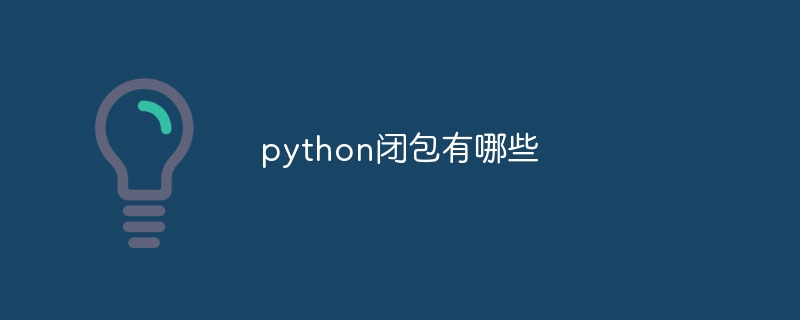 python闭包有哪些Oct 30, 2023 pm 04:53 PM
python闭包有哪些Oct 30, 2023 pm 04:53 PMpython闭包主要包括函数闭包和装饰器闭包。详细介绍:1、函数闭包是指在一个函数内部返回另一个函数,并且返回的函数能够访问到其内部变量。这样的返回函数就是函数闭包,函数闭包在程序中可以被反复使用,因此可以用来实现一些功能上的封装;2、装饰器闭包是指在使用装饰器时,被装饰的函数并没有直接被调用,而是被包装在一个函数内部,并返回一个新的函数。这个新的函数就是一个装饰器闭包等等。
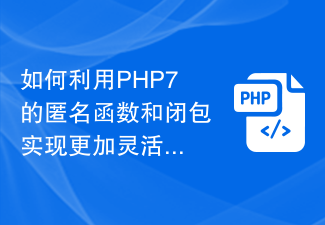 如何利用PHP7的匿名函数和闭包实现更加灵活的代码逻辑处理?Oct 21, 2023 am 10:21 AM
如何利用PHP7的匿名函数和闭包实现更加灵活的代码逻辑处理?Oct 21, 2023 am 10:21 AM如何利用PHP7的匿名函数和闭包实现更加灵活的代码逻辑处理?在PHP7之前,我们经常使用函数来封装一段特定的逻辑,然后在代码中调用这些函数来实现特定的功能。然而,有时候我们可能需要在代码中定义一些临时的逻辑块,这些逻辑块没有必要创建一个独立的函数,同时又不想在代码中引入太多的全局变量。PHP7引入了匿名函数和闭包,可以很好地解决这个问题。匿名函数是一种没有名
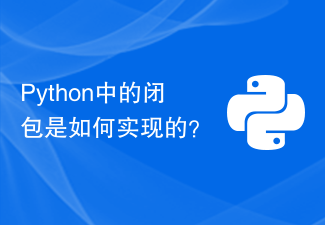 Python中的闭包是如何实现的?Oct 21, 2023 am 10:33 AM
Python中的闭包是如何实现的?Oct 21, 2023 am 10:33 AMPython中的闭包是如何实现的?闭包是一种函数内部定义的函数,并且在函数内部引用了外部函数的变量。这种特性使得内部函数可以访问外部函数的变量,并且在外部函数执行完毕后,闭包仍然可以访问和操作外部函数的变量。闭包在Python中通过以下几个步骤来实现:定义外部函数,并在其中定义内部函数:首先,我们需要在外部函数内部定义一个内部函数。这个内部函数即是闭包。de
 react有哪些闭包Oct 27, 2023 pm 03:11 PM
react有哪些闭包Oct 27, 2023 pm 03:11 PMreact有事件处理函数、useEffect和useCallback、高阶组件等等闭包。详细介绍:1、事件处理函数闭包:在React中,当我们在组件中定义一个事件处理函数时,该函数会形成一个闭包,可以访问组件作用域内的状态和属性。这样可以在事件处理函数中使用组件的状态和属性,实现交互逻辑;2、useEffect和useCallback中的闭包等等。
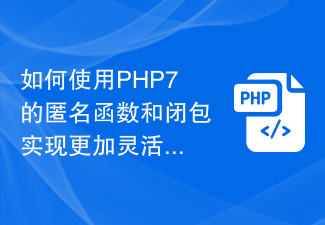 如何使用PHP7的匿名函数和闭包实现更加灵活和可复用的代码逻辑?Oct 24, 2023 am 10:30 AM
如何使用PHP7的匿名函数和闭包实现更加灵活和可复用的代码逻辑?Oct 24, 2023 am 10:30 AM如何使用PHP7的匿名函数和闭包实现更加灵活和可复用的代码逻辑?在PHP编程领域中,匿名函数和闭包是非常有价值和强大的工具。PHP7引入了一些新的语言特性,使得使用匿名函数和闭包更加方便和灵活。本文将介绍如何使用PHP7的匿名函数和闭包来实现更加灵活和可复用的代码逻辑,并提供一些具体的代码示例。一、匿名函数匿名函数是一种没有名称的函数。在PHP中,可以将匿名
 怎么样减少闭包的产生Oct 27, 2023 pm 04:28 PM
怎么样减少闭包的产生Oct 27, 2023 pm 04:28 PM减少闭包产生的方法有避免不必要的闭包、控制闭包的返回值、使用弱引用、减少不必要的全局变量、合理使用循环和递归、使用事件代理、编写单元测试、遵循设计原则和使用工具进行代码分析等。详细介绍:1、避免不必要的闭包,在很多情况下,闭包并非必需的,可以用模块模式来实现私有变量,避免使用闭包;2、控制闭包的返回值,在使用闭包时,应该尽量控制闭包的返回值,如果闭包返回的是基本数据类型等等。
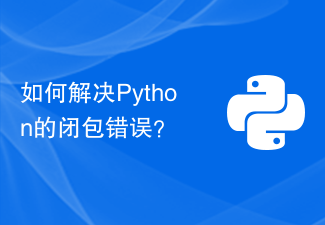 如何解决Python的闭包错误?Jun 24, 2023 pm 11:23 PM
如何解决Python的闭包错误?Jun 24, 2023 pm 11:23 PMPython是一种非常流行的编程语言,因为它非常易学易用,同时也具备了强大的功能。其中,闭包是Python中的一种函数,它可以在函数的内部定义另一个函数,并返回这个函数作为函数的返回值。尽管闭包非常方便,但有时会出现某些错误,比如闭包错误。本文将介绍如何解决Python的闭包错误。初步了解闭包在Python中,闭包是由一个内部函数和一个定义在内部函数之外的函


Hot AI Tools

Undresser.AI Undress
AI-powered app for creating realistic nude photos

AI Clothes Remover
Online AI tool for removing clothes from photos.

Undress AI Tool
Undress images for free

Clothoff.io
AI clothes remover

AI Hentai Generator
Generate AI Hentai for free.

Hot Article

Hot Tools

Dreamweaver Mac version
Visual web development tools

mPDF
mPDF is a PHP library that can generate PDF files from UTF-8 encoded HTML. The original author, Ian Back, wrote mPDF to output PDF files "on the fly" from his website and handle different languages. It is slower than original scripts like HTML2FPDF and produces larger files when using Unicode fonts, but supports CSS styles etc. and has a lot of enhancements. Supports almost all languages, including RTL (Arabic and Hebrew) and CJK (Chinese, Japanese and Korean). Supports nested block-level elements (such as P, DIV),

PhpStorm Mac version
The latest (2018.2.1) professional PHP integrated development tool

SublimeText3 Chinese version
Chinese version, very easy to use

MinGW - Minimalist GNU for Windows
This project is in the process of being migrated to osdn.net/projects/mingw, you can continue to follow us there. MinGW: A native Windows port of the GNU Compiler Collection (GCC), freely distributable import libraries and header files for building native Windows applications; includes extensions to the MSVC runtime to support C99 functionality. All MinGW software can run on 64-bit Windows platforms.





